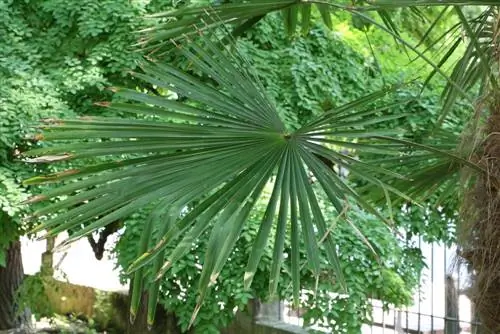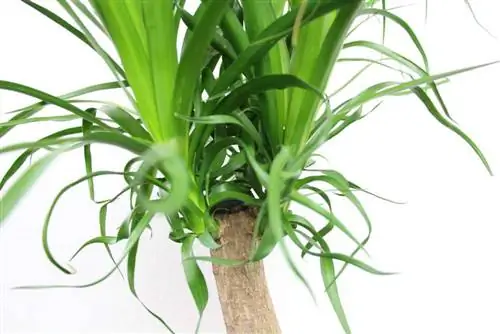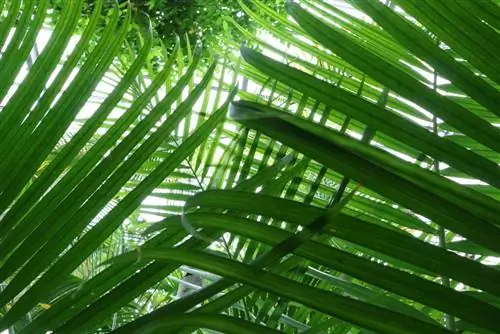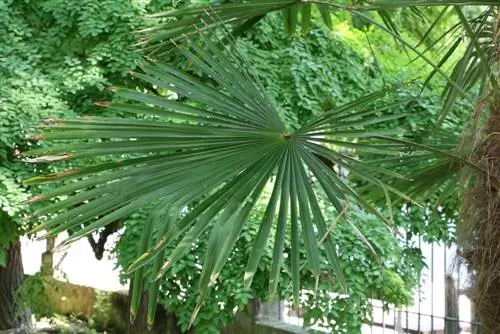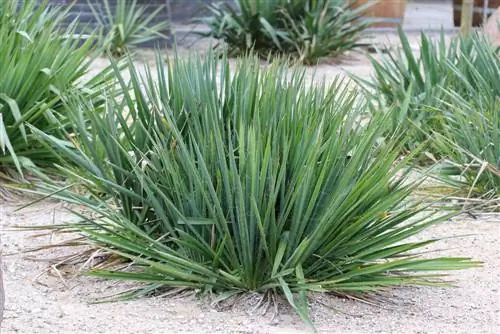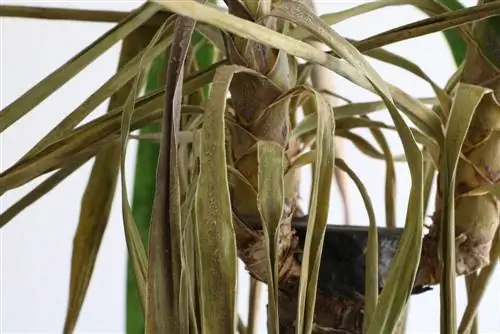- Author admin [email protected].
- Public 2023-12-17 03:39.
- Last modified 2025-06-01 06:48.
The Chinese hemp palm was known under the Latin name Chamaerops excelsa until 1861, under which it is still occasionally sold today. The hemp palm is a medium-tall fan palm that can reach 12 to 15 meters high when it is old. Since Trachycarpus fortunei is kept as an ornamental plant in many gardens in Europe, it is the most frequently planted palm in Europe. It is extremely robust and usually copes well with our winters with protection. It is also moisture tolerant.
Fruiting, female hemp palms grow significantly slower than the male specimens.
Location
When planted, the hemp palm grows best in regions with mild winters, i.e. in the Rhineland, on the Lower Rhine, in the Rhine-Main area, on the Upper Rhine and on the North Sea coast and on the islands. In the rest of Germany, the palm tree usually needs to be well protected. It needs a protected, sunny location, close to a warm house wall or in a sheltered corner.
For potted plants, Trachycarpus fortunei is also placed in a sunny spot in summer. It is always important to have a location protected from the wind.
Young plants are better kept in the pot, older ones can then be planted out properly.
Planting substrate
The planting substrate should be permeable and slightly acidic. For older specimens you can also simply use garden soil.
Planting a potted plant into the bed should always be done in spring and never in autumn.
Care
If you water the hemp palm properly in summer, you can stimulate its growth. You should make sure that the water is not too hard, as palm trees cannot tolerate that. The top layer of soil should be allowed to dry thoroughly between waterings. In winter you limit watering. The plant substrate must not dry out completely.
Growth
The Trychycarpus fortunei is a stable palm species that grows very slowly and can reach a total height of around 10 meters.
The plant, also known to plant lovers as the hemp palm, originally comes from the high mountains of Asia. There it grows at an altitude of around 2500 meters above sea level.
When caring for the Trachycarpus, there are only a few basic rules that you have to follow so that the hemp palm can thrive properly.
Substrate
The hemp palm does not have particularly high demands when it comes to selecting the soil. Pure garden soil or slightly acidic soil is sufficient here. The water should not contain too much lime and the soil should never be wet, just kept moist.
The ideal location for the hemp palm is in partial shade, but it can also tolerate sunny places. You can fertilize the hemp palms with a nitrogen-rich liquid fertilizer or a slow-release fertilizer. Fertilizing the Trachycarous should be done approximately every three weeks.
Repotting
You can repot or plant out the hemp plant when it has reached a certain size.
Getting the hemp palm safely through the winter
Overwintering the Trychcarpus fortunei is easy, as the hemp palm is already used to a cool climate due to its place of origin. The room in which the hemp palm is kept for overwintering should have a brightness of around 700 lux. If the room temperature is no more than 5 degrees Celsius, the room can also be darker than 700 lux.
Basically, the Trychcarpus tolerates the climate in Central Europe well and can also overwinter at higher temperatures between 15 and 20 degrees Celsius. This is also the temperature range in which the hemp palm can grow and thrive best.
Under no circumstances should the room in which the hemp palm hibernates be cold and damp. Dry cold is beneficial for the hemp palm.
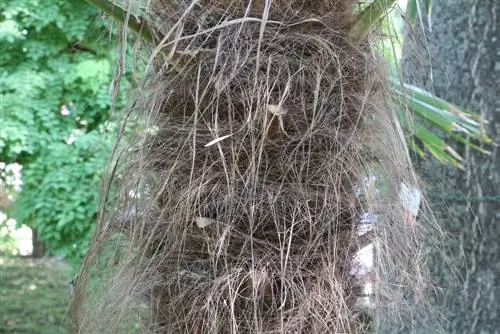
In winter it is also possible to leave the Trachycarpus fortunei outside. But you should make sure that it is not permanently exposed to temperatures below minus 10 degrees Celsius. This especially applies to the still young plants. Adult hemp palms that have been planted for three to four years can tolerate temperatures of up to minus 17 degrees Celsius.
Fertilize
During the main growth phase, fertilize every 3 weeks with a nitrogen-rich liquid fertilizer. You can also mix a slow-release fertilizer into the soil when repotting in spring.
Wintering
If it gets colder than -10 ºC and windy, the leaves of the hemp palm should be protected. Potted plants then have to go to winter quarters. This should be a cool, bright room. Overwintering is best done at 5 to 10 ºC. At temperatures below 5ºC it can also be a darker room. The plant thrives on relatively little light. During the rest period, the plant substrate must never dry out completely.
Tip:
The hemp palm survives dry frost better than a musty, damp basement. You should avoid putting the palm tree in and out frequently.
In the open field, protective measures must be taken for Trachycarpus fortunei from around -10 ºC. Otherwise, leaf damage and even death of the leaf fans can occur. Long-lasting permafrost with deep ground frost is dangerous for the Chinese hemp palm. The roots and the palm heart can be damaged. Both lead to the loss of the plant. Planting the hemp palm was successful up to winter hardiness zone 7b, but with moisture and winter protection.
Pests
Especially when the air is dry, the hemp palm, like all other palms, tends to be attacked by spider mites, scale insects and mealybugs. Regular showering or spraying with lukewarm water helps prevent pest infestation.
Trachycarpus fortunei - cost of a hemp palm
A 50 to 60 cm tall Chinese hemp palm costs around 20 to 25 euros. A 120 to 140 cm tall one costs around 150 euros. If you want to plant a 3 to 4 meter high palm tree in your garden, you have to expect a price of 1,000 euros.
When purchasing a hemp palm, it is cheapest if you grow and plant it yourself. But you can also buy fully grown specimens in plant and garden centers as well as in special online shops such as palmenhandel.de.
A Trachycarpus with a height of almost 1.5 meters costs on average between 70 and 100 euros. The smaller hemp palms, which are still very young with a height of 30 centimeters, cost between 15 and 25 euros. When purchasing a Trachycarpus fortunei hemp palm, you should know that this type of palm can reach a total height of 10 to 12 meters. Depending on the origin and type of cultivation, the price for a hemp palm can be as high as 350 euros. These hemp palms have already reached a height of almost two meters and can already be planted out.

